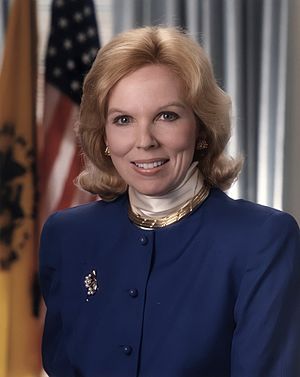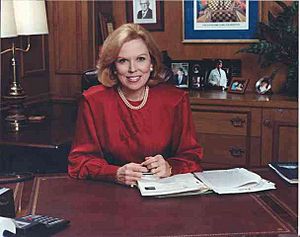Bernadine Healy facts for kids
Quick facts for kids
Bernadine Healy
|
|
|---|---|
 |
|
| 13th Director of the National Institutes of Health | |
| In office April 9, 1991 – June 30, 1993 |
|
| President | George H. W. Bush Bill Clinton |
| Preceded by | James Wyngaarden |
| Succeeded by | Harold Varmus |
| Personal details | |
| Born |
Bernadine Patricia Healy
August 4, 1944 New York City |
| Died | August 6, 2011 (aged 67) Gates Mills, Ohio |
| Education | Vassar College Harvard Medical School |
| Medical career | |
| Profession | Physician |
| Field | Cardiology |
| Institutions | Cleveland Clinic National Institutes of Health Johns Hopkins University Ohio State University |
Bernadine Patricia Healy (August 4, 1944 – August 6, 2011) was an American heart doctor, also known as a cardiologist. She made history as the first woman to lead the National Institutes of Health (NIH). The NIH is a very important government agency that helps fund medical research.
Throughout her career, Dr. Healy held many top jobs. She worked at famous places like Johns Hopkins University, the Cleveland Clinic, Ohio State University, and Harvard University. She also led two major organizations: the American Red Cross and the American Heart Association. She often shared her health knowledge in the news and wrote for U.S. News & World Report.
Contents
Early Life and Education
Bernadine Healy was born in New York City on August 4, 1944. She grew up in Long Island City, Queens, with her three sisters. Her parents always told them that education was very important.
In 1962, she finished high school at Hunter College High School in Manhattan. She was the top student in her class. She then went to Vassar College on a full scholarship. She studied chemistry and philosophy and graduated with top honors in 1965.
Next, she attended Harvard Medical School, also on a full scholarship. She was one of only ten women in her class of 120 students. After graduating in 1970, she trained at Johns Hopkins School of Medicine and Johns Hopkins Hospital. She became the first woman to join the full-time heart doctor team there. She quickly became a professor of medicine.
For eight years, she was in charge of the heart care unit at Johns Hopkins Hospital. She also helped organize a special event about women in medicine. This event looked at the chances and challenges women doctors faced. It also honored Mary Elizabeth Garrett, who helped make sure Johns Hopkins Medical School welcomed women students.
Leading Health Organizations
While at Johns Hopkins, Dr. Healy took on leadership roles in several medical groups. These included the American Federation of Clinical Research and the American College of Cardiology. She also worked with the American Heart Association, which she later led as its volunteer president. She advised the National Heart, Lung and Blood Institute.
A group called Age of Autism named her "Person of the Year" in 2008. This was because she said that more research was needed to fully understand if vaccines could trigger autism in some people. However, it's important to know that scientists widely agree that there is no link between vaccines and autism.
At the Cleveland Clinic
In 1985, Dr. Healy moved to Cleveland. She became the head of the Cleveland Clinic Lerner Research Institute and continued to practice as a heart doctor. She helped start new research programs in areas like molecular biology and cancer. She also led important studies on heart health and treatments. She helped create a program for medical students with Ohio State University. This program later became the Cleveland Clinic Lerner College of Medicine.
Leading the American Red Cross
In 1999, Dr. Healy became the president and CEO of the American Red Cross. She wanted to bring all the different services and volunteers together. Her motto was "Together we can save a life."
Her time at the Red Cross had some challenges. In 2001, the organization faced criticism for how it handled blood products. Also, after the September 11 attacks, the Red Cross received many donations. Some people, including the New York State Attorney General, felt the organization was not clear about how these funds would be used. The Red Cross then changed its policy to be more transparent.
Dr. Healy also pushed for Magen David Adom, Israel's Red Cross society, to be allowed to join the international group without changing its symbol. She was known for her strong leadership style. Due to disagreements, she left the Red Cross at the end of 2001.
Government Service
Presidential Advisor
President Ronald Reagan appointed Dr. Healy as a deputy director in the White House Office of Science and Technology Policy. She advised on important science and technology issues. She also served on advisory groups for Presidents George H. W. Bush and George W. Bush.
Director of the National Institutes of Health
In 1991, President George H. W. Bush chose Dr. Healy to lead the National Institutes of Health (NIH). She was the first woman to hold this important position. During her two years there, she started many new projects.
She helped create a major research lab for human genetics. She also brought in top scientists, like Dr. Francis Collins, to lead the Human Genome Project. This project aimed to map all the genes in humans. Dr. Healy also made sure that NIH would fund clinical trials that included both men and women when the health condition affected both sexes.
Other Important Roles
American Heart Association
From 1988 to 1989, Dr. Healy was president of the American Heart Association. She worked hard to teach people that heart disease affects women just as much as men. She wanted everyone to know it was "not a man's disease in disguise."
U.S. Senate Candidate
In 1994, Dr. Healy ran for a seat in the United States Senate for Ohio. She was a Republican candidate. She came in second place in her party's primary election.
At Ohio State University
From 1995 to 1999, Dr. Healy was a professor and dean of the College of Medicine at Ohio State University. During her time, the college grew. It added a School of Public Health, becoming the College of Medicine and Public Health.
She helped the medical school become a National Center of Excellence in Women's Health. She also helped create a new department for bone and joint surgery, called orthopaedics. She brought in top researchers to expand programs in cancer research and heart surgery.
Advisory Boards
Dr. Healy served on many important medical advisory groups throughout her career. These included committees for the National Academy of Sciences and the National Academy of Engineering. She also advised the United States Department of Energy, NASA, and the National Institutes of Health. She was a strong voice against smoking and its harmful effects on the heart.
Media Work
Dr. Healy was a medical expert for many news channels, including CBS, PBS, MSNBC, CNN, and Fox News Channel. She wrote a regular column called "On Health" for U.S. News & World Report. In her column, she wrote about many health topics, from women's health to cancer and tattoos.
She became part of a discussion when she questioned a 2004 report. This report said there was no link between childhood vaccinations and autism. Dr. Healy suggested that the government might have avoided studying if some groups of people could be more affected by vaccines. She worried that if a link were found, people might stop vaccinating.
Family Life
Bernadine Healy was married to Dr. Floyd D. Loop, who was also a heart surgeon and a former CEO of the Cleveland Clinic. They had one daughter named Marie McGrath Loop. Dr. Healy also had another daughter, Bartlett Bulkley, from an earlier marriage.
Death
Dr. Bernadine Healy passed away on August 6, 2011, in Gates Mills, Ohio. She was 67 years old. She had been battling brain cancer for thirteen years.
Popular Media
Dr. Healy's life and work were featured in a 2018 episode of Malcolm Gladwell's podcast, "Revisionist History". The episode was called "Strong Verbs, Short Sentences" (Season 3, Episode #9).
See also
 In Spanish: Bernadine Healy para niños
In Spanish: Bernadine Healy para niños



